Ever since eMTBs hit the scene less than a decade ago, their design has seen something of a ‘turbo-charged’ evolution and development. We analyse the latest geometry trends and crunch the numbers to find out how eMTB geometry influences your fun on the trail.
Looking at the current cycling market, almost every established bike brand now has one or more eMTBs in their lineup and we are seeing many new eMTB-specific brands stepping in to the arena. Compared to non-motorised bikes, the evolutionary timeline of eMTBs has been just a snap of the fingers, but in the last few years, we have seen great changes in both performance and comfort. It’s time for some forensic science. Let’s delve into the DNA of our ebikes. What makes a great eMTB and are they diverging from their non-motorised siblings?
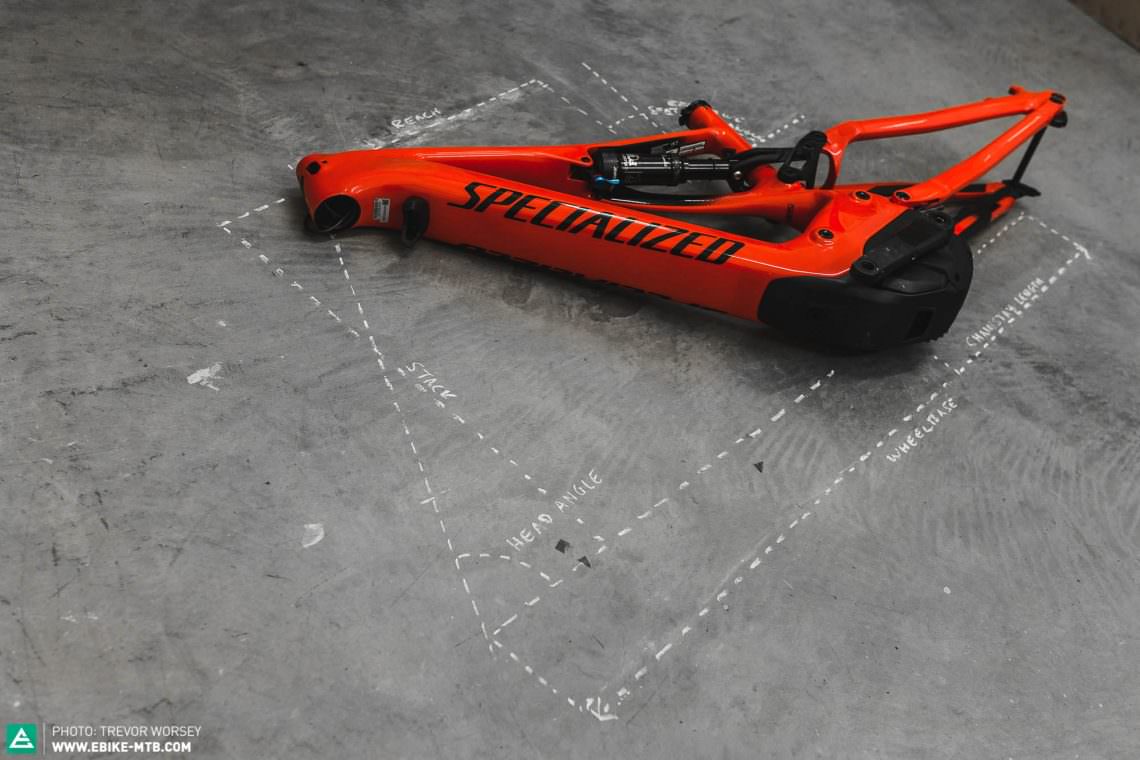
How does geometry impact eMTB handling?
For a bike to perform well on the trail, it needs three genetic traits: well-chosen components, optimised suspension and most importantly, good geometry. If any of these traits are lacking, then your fun and enjoyment will be compromised. Geometry defines how your bike feels on the trail and how you interact with your bike. Whether you’re looking for comfort, stability, confidence or agile handling, all those properties boil down to good geometry. Geometry dictates how we sit on the bike, how our weight is distributed between the wheels, where our hands and feet are located, how the bike handles different trail gradients and how we transfer our power to the drivetrain. But what is it that makes a geometry ‘good’?
Geometry tables, don’t fall into the trap
Before we get lost in the numbers, we must first introduce you to bike geometry’s first law.
Geometry values are a very useful tool but to truly understand a bike’s character, we have to consider the geometry and suspension as a whole.
It’s easy to become fixated on the numbers in a geometry chart. Comparing one bike to the next based solely on an isolated value like the head angle or the chainstay length is like basing your next car purchase on the number of cupholders it has. This might be important information if you enjoy coffee-on-the-go but it won’t tell you about the whole picture. Geometry tables provide an indication of a bike’s expected performance but we must also consider the effects of different suspension platforms and componentry selection, as they often have an just as important influence on the bike’s riding characteristics. Uniquely to eMTBs, one design consideration that has a huge impact on a bikes character is where the battery is located. Designers and manufacturers now understand that the lower the battery and motor are positioned in the frame the better, as this results in a lower center of gravity.
Once we understand that a bike’s riding characteristics are not defined by a single number, but by all the numbers in balance, we can start to understand how the different trends have shaped, and are still shaping, eMTB evolution.
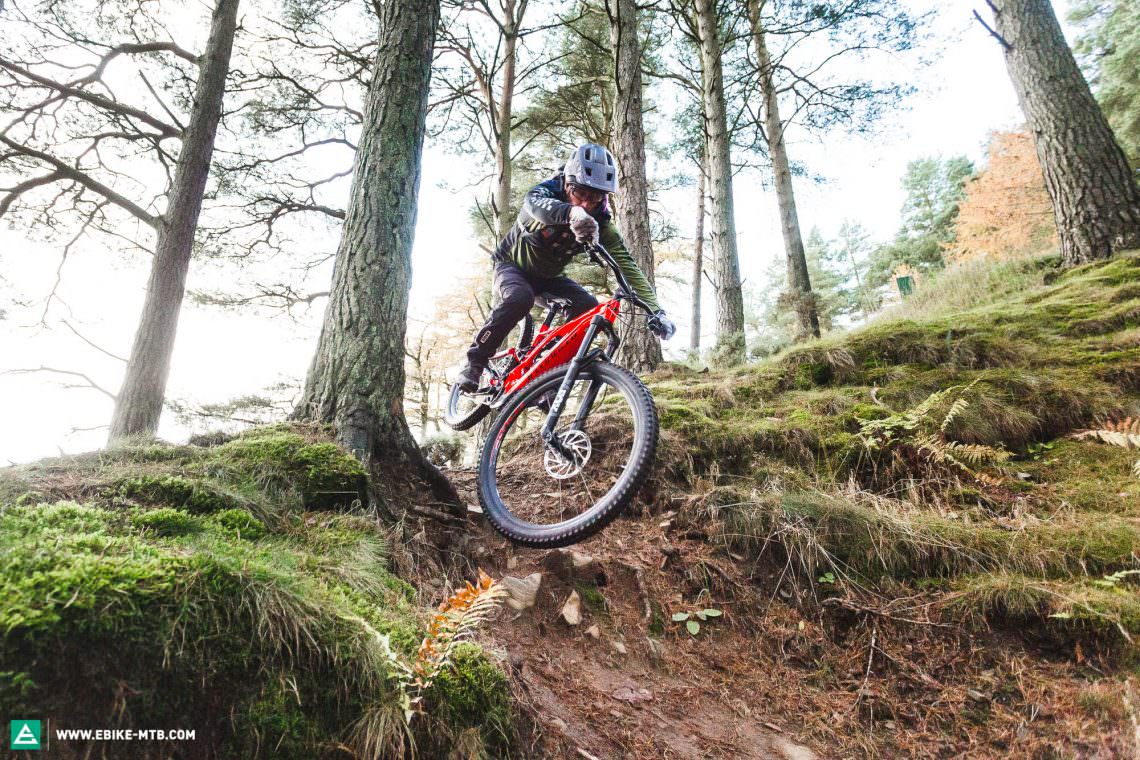
eMTB Geometry basics
But before we open Pandora’s box we must first learn some new vocabulary. In general, eMTB geometry is very simple. If you have a hardtail (front suspension only), then the eMTB frame comprises a fixed front and rear triangle. If you have a full-suspension bike the front frame triangle is attached via rotating pivots to a rear triangle. On a full-suspension bike the relationship between the front and rear triangle, and the corresponding geometry values change as the bike moves through its suspension travel.
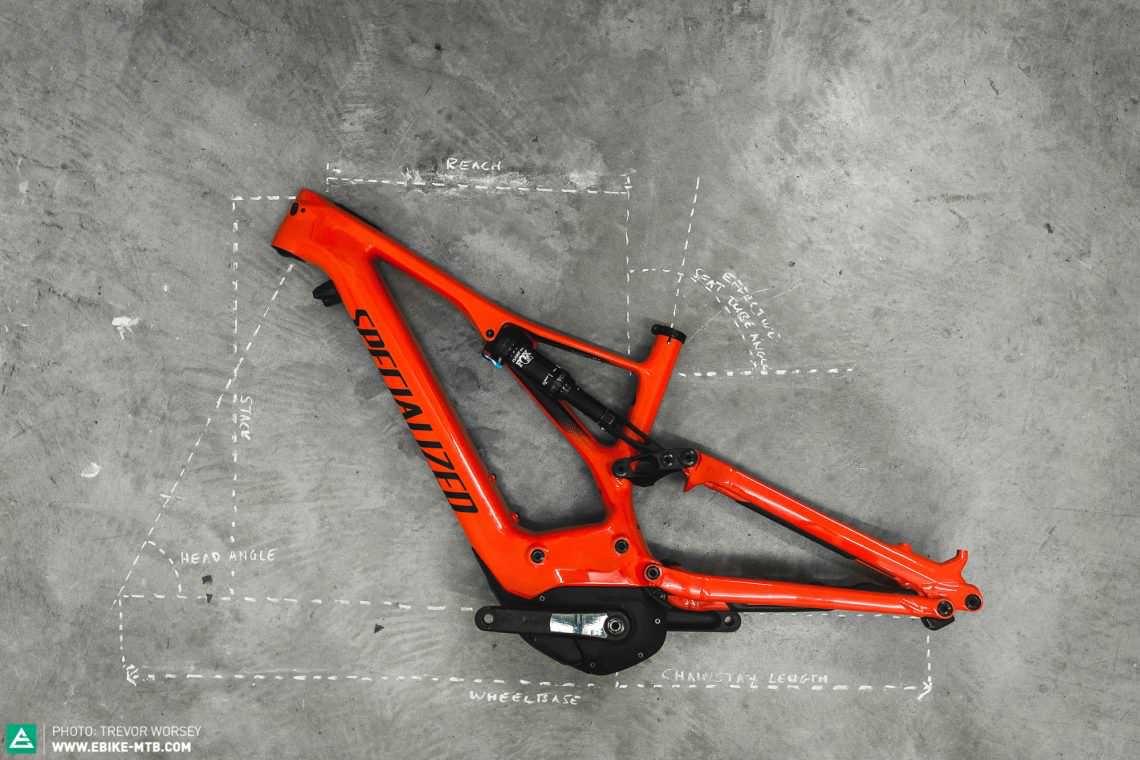
Chainstay length
Chainstay length is the horizontal distance between the centre of the bottom bracket and the centre of the rear axle. On most bikes, the chainstay length changes as the bike moves through its suspension travel. However this change is never communicated in geometry tables.
Head angle
The head angle is the angle between the ground and the steering axis of the head tube. Slacker angles generally mean that the steering is more stable, whereas steeper angles give a more active steering feel.
Reach
Reach is the horizontal distance from the centre of the bottom bracket to the centre of the top of the head tube. Reach tells you how long the bike will feel when you are standing, but due to different seat tube angles is not a good indication of how long a bike will feel while seated.
Stack
Stack is the vertical distance measured from the centre bottom of the bracket to the top of the head tube (where the fork steerer exits the frame). Stack gives a good idea of how tall the front of the bike will feel on the trail.
Reach / stack ratio
The reach/stack ratio of a bike gives a good indication of how your position will feel while riding. Bikes with a lower ratio (under around 0.75) will generally feel taller with a more upright riding position, whereas bikes with a higher ratio (above 0.75) will feel lower and more stretched.
Seat tube angle
This is the angle measured between the ground and the line drawn from the centre of the bottom bracket to the centre of the seat rails at a given seat height. Many brands measure this differently. Due to kinked seat tubes, this angle can vary wildly at different seat heights so it is not easy to compare one eMTB to the next.
Seat tube length
The seat tube length is the distance measured from the centre of the bottom bracket to the top of the seat tube. This gives us an indication of what length dropper post can be inserted into the frame. However on many frames, pivot locations and kinks in the tube reduce the maximum insertion depth.
Wheelbase
The wheelbase is the horizontal distance measured between the points where the front and rear wheel contact the ground.
Effective top tube length
The effective top tube length is the horizontal distance from the top tube/head tube junction to the seat tube. While this measurement does not take into account the amount of seat tube extension it is the best indication of how long a bike will feel when seated.
In the beginning, eMTBs didn’t have to reinvent the wheel
When they were first introduced, eMTB’s didn’t have to reinvent the wheel. With some top cycling brands surpassing 50 years of experience designing and building mountain bikes, designers already knew how to build great handling bikes. However, when faced with the task of integrating heavy and unwieldy first-generation motors, bike designers found themselves limited in terms of geometry choices and compromises had to be made. Since then, with successive generations of smaller and lighter motors, bike designers now have more freedom to design with less compromise. So how do modern eMTBs compare to their non-motorised siblings? Does the geometry of leading non-motorised bikes work for eMTBs, or do their needs differ?
To find out, we pooled the geometry values of the leading eMTBs from our ‘Best eMTB of 2020’ group test (Click for review) and compared them against 11 of the leading 130–150 mm trail bikes in ENDURO’s most recent group test. The numbers were very close indeed. Comparing size large bikes, eMTB reach was only 2.8 mm longer on average than the non-motorised bikes (463.4 ±3.1 mm vs. 460.5 ±2.5 mm) with an 11.6 mm shorter seat tube height (459.5 ±4.6 mm vs. 471.1 ±3.4 mm). The average head angle and seat angle of the eMTBs vs non-motorised bikes are also both 0.8° slacker and 0.4° steeper (65.1 ±0.2° vs. 66.3 ±0.2° and 75.3 ±0.2° vs. 74.9 ±0.2° respectively). The only significant differences between the geometry of the average eMTB compared to the average non-motorised bike are that eMTB’s have a 6.7 mm taller stack height (625.6 ±3.6 mm vs .618.9 ±4.3 mm) 12.4 mm longer chainstays (446.0 ±3.4 mm vs. 434.3 ±0.9 mm) and a 33.4 mm overall longer wheelbase (1242.7 ±7.5 mm vs. 1209.3 ±4.2 mm).

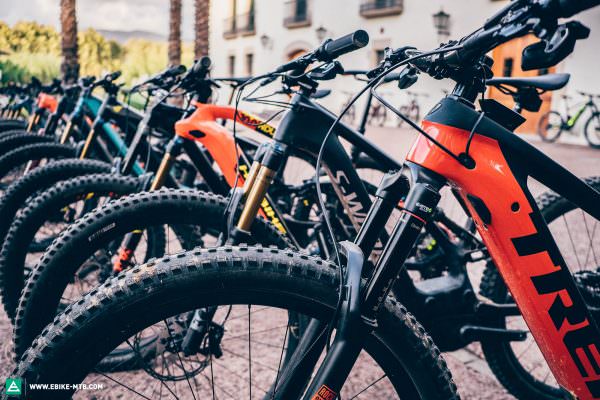
2019 vs 2020? What difference does a year make?
Are eMTBs still evolving though? What happens when we look at a short time scale. How have eMTB’s changed over the last year? Comparing the eMTB’s from our 2020 group test in this issue with the eMTB’s from our 2019 group test, we can see how trends are shaping eMTB evolution. The latest 2020 eMTBs have seen changes in their key numbers. On average the head angle is 0.9° slacker than in 2019 (65.9 ±0.2° vs. 65.0 ±0.2°) and the seat tube angle is 0.6° steeper (74.6 ±0.3° vs. 75.3 ±0.3°). With the advent of longer dropper posts, eMTBs are growing lower too, with an average 10.6 mm shorter seat tube length on the 2020 bikes (470.1 ±3.1 mm vs. 459.5 ±4.6 mm). Overall the wheelbase remains largely unchanged (1242.6 ±8.2 mm vs. 1242.7 ±7.4 mm) as do reach (464.1 ±2.8 mm vs. 463.3 ±3.1 mm ) and stack (628.2 ±4. 6mm vs. 625.6 ±3.6 mm) for 2019 and 2020. Interestingly, the average eMTB chainstay length has been reduced 9.3 mm from 2019 to 2020 (446.7 ±3.4 mm Vs 456.0 ±4.4 mm) but is still 12.4 mm longer than the average non-motorised MTB.
Overall we can see that the best eMTBs share much of their geometry DNA with cutting edge trail bikes but are on average a little lower, longer and slacker. So do we already have our answer?
Do we already have the perfect genetic code for a great riding eMTB?
The answer is yes, but with a proviso. As battery capacities grow increasingly larger, and in-tube designs add more engineering constraints for bike designers, weight distribution is growing ever more important. Even with great geometry, if the battery and motor are placed in the incorrect location, the bike handling and suspension will suffer. Unique to eMTBs, lines are blurring between design and geometry and it’s more important than ever to consider the bike as a whole, rather than individual values, specs or numbers in isolation.
What’s the future for eMTB geometry?
While many argue that non-motorised bikes have reached the pinnacle of their evolution is there still untapped potential with eMTB design? We take a hypothetical look to the future and predict how emerging trends will shape eMTB geometry.
Will seat tube angles grow increasingly steeper?
We have observed with non-motorised bikes that steeper seat angles lead to a more efficient climbing position on steep gradients and increased traction on the front wheel and are now seeing eMTBs with seat angles up to 78°. Looking at a popular example, the latest Specialized Kenevo has just added a whopping 2° to its seat tube angle. With eMTBs’ ability to climb very steep terrain, the improved position of a steeper seat angle to keep weight on the front wheel becomes even more beneficial. There has to be balance though. The steeper the seat angle, the more pressure is placed on the rider’s arms on flatter terrain, so long tour riders may not celebrate this new trend. We expect to see divergence within the categories, with slacker, long-travel eMTBs using steeper seat tube angles to keep the front wheel weighted on the climbs, while all-rounders with a greater mass market appeal will maintain more conservative seat tube angles for a more balanced seating position.
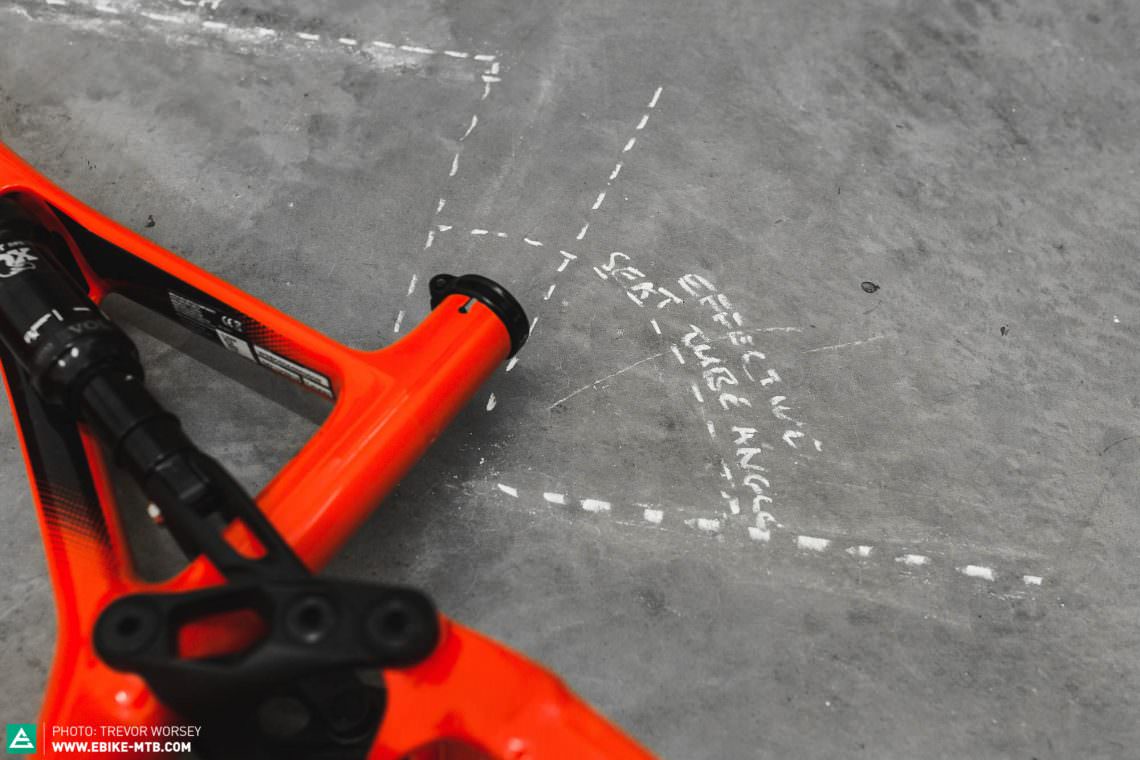
Will eMTBs adopt super short chainstays?
For many years we have been told by bike marketing spiel that short chainstays make a bike more agile and that long ones make them stable. In reality, chainstay length is more complex and should be considered as part of the whole system. In many cases, having to squeeze a motor into the frame dictates that eMTBs have generally had longer chainstays than non-motorised bikes. The length of the chainstay determines how the rider’s weight is distributed between the front and rear wheel. Very short chainstays bring the rear wheel closer to the bottom bracket and further under the rider, putting more of the rider’s weight over the rear wheel. On steep climbs, less weight on the front wheel can cause it to lift and wander. We all know that eMTBs open up a whole new world of technical climbing fun and therefore super short chainstays can be a disadvantage. Just look at the Specialized Levo: the 459 mm chainstays may look huge compared to the 437 mm stays on the non-motorised Specialized Stumpjumper but the longer chainstays certainly help when it comes to keeping the front wheel under control when climbing steep terrain. We predict that even if motors grow smaller, the best eMTBs will maintain longer chainstays for more balanced climbing performance, increased grip and increased confidence for less experienced riders.
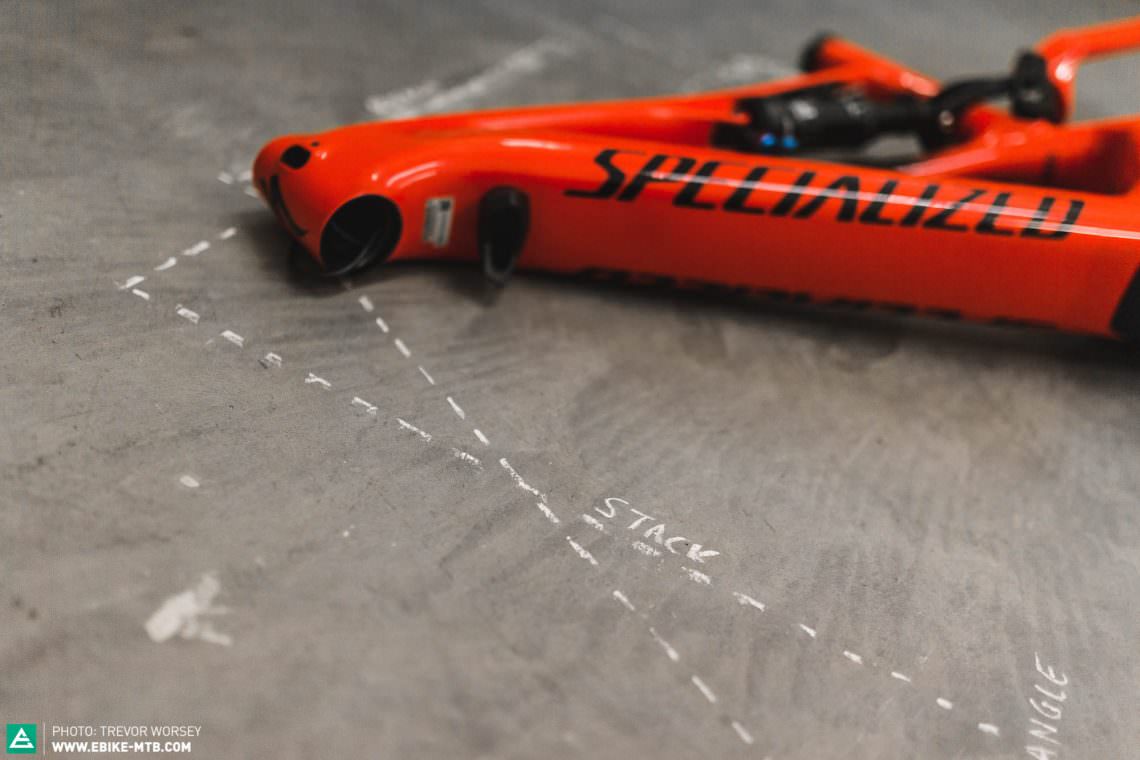
Do we need to go crazy long and slack?
So what about the biggest geometry trend that is sweeping the non-motorised bike world. Three buzz words that have been pivotal to the marketing of almost every new model on the market. Long, low and slack. In pursuit of more stability at speed, non-motorised MTBs are growing longer and slacker than ever before. Why? Generally, lengthening the wheelbase and slackening the head angle gives increased confidence and security at speed at the expense of agility. However, with the stabilising effect of the low-slung motor, eMTBs are already inherently stable, and you could argue that the most desirable property from an eMTB is confident agility. A very long and slack bike requires a more dynamic rider to achieve optimum performance and requires a lot of effort to lift the front wheel. Combined with the inherent stability of an eMTB, going super-long can leave the bike feeling lazy and ‘stuck to the ground’. We predict that while there will always be outliers, the best eMTBs will maintain more balanced geometry without radical dimensions or angles, maintaining an agile feel that offsets the inherently stabilising effect of the low slung battery and motor weight.
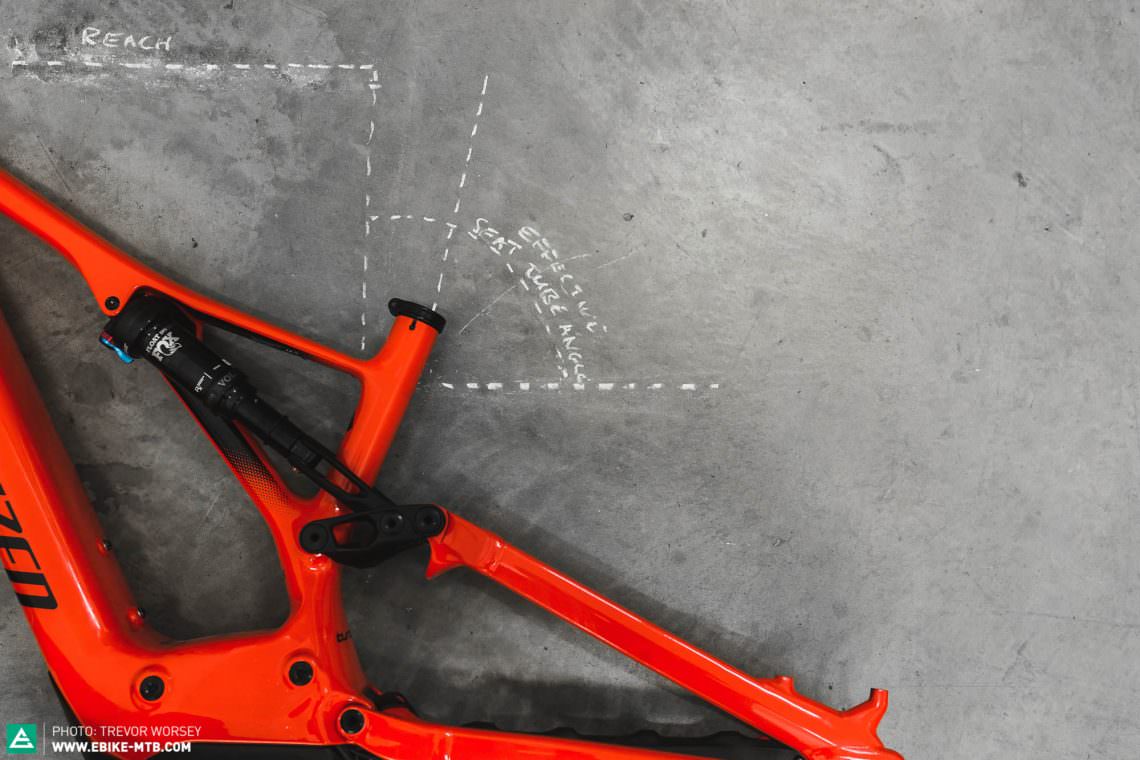
The days of defining bike size by seat tube height are over.
Traditionally, correct bike sizing has been defined by the height of the seat tube. Times are changing. We are now seeing brands like Specialized take on a new sizing concept, basing the size of the bike not by the height of the seat tube, but by the length of front triangle. With the advent of longer dropper posts, designers can reduce the seat tube heights across all sizes, meaning that even shorter riders now have the option to choose if they want to ride a longer bike. It’s not just Specialized either. We are seeing seat tube heights decreasing across all of the most popular eMTB brands. In the future, we predict we will see this sizing strategy becoming more widespread, giving riders more options to choose the bike that best fits their riding style, independent of their inside leg measurement.
Form over function, a warning for the future
We must also be cautious of hurdles to development. Take the latest trend of SUV eMTBs, which offer exciting potential and opportunities. However, in the pursuit of a rugged aesthetic, compromises are often made to the handling. While heavy, wide top tubes may look aggressive and tough, from a handling perspective they only reduce rider confidence, security and enjoyment. The future for SUV eMTBs is certainly bright, but sometimes trends can lead us down dead ends.

Genetic engineering and tuning your bikes DNA
While there is little you can do to change your eMTB’s frame geometry, you can make some small adjustments to your eMTB that can have a big impact on ride feel. If you want to optimise the geometry of your bike to better suit your riding style, we take you through the changes you can make.
All eMTBs feature limited but important adjustability of the key contact points where you interact with the bike, including the fore-aft position of the saddle and the height of the handlebar. Optimising the bad height and seat position can have a big impact on how your bike handles and climbs, giving you more control, comfort and security. First, a disclaimer. Your position on your bike is heavily influenced by suspension setup, so make sure you have your fork and shock sag set correctly before tuning your position on the bike.

Changing your saddle fore-aft position
Nearly all saddles feature rails that give 2–4 cm of fore-aft adjustment in the seat clamp. If you spend a lot of time climbing steep gradients and find that you feel your weight is far back on your bike or the front wheel lifts off the ground and is hard to keep in line, you may want to slide your seat forward on its rails. Moving the seat forwards steepens the effective seat tube angle, moving your weight towards the front wheel to give a more efficient position on steep climbs and get more grip from the front tire. We are now seeing a growing trend from riders who enjoy technical climbing to run their saddles as far forwards as possible.
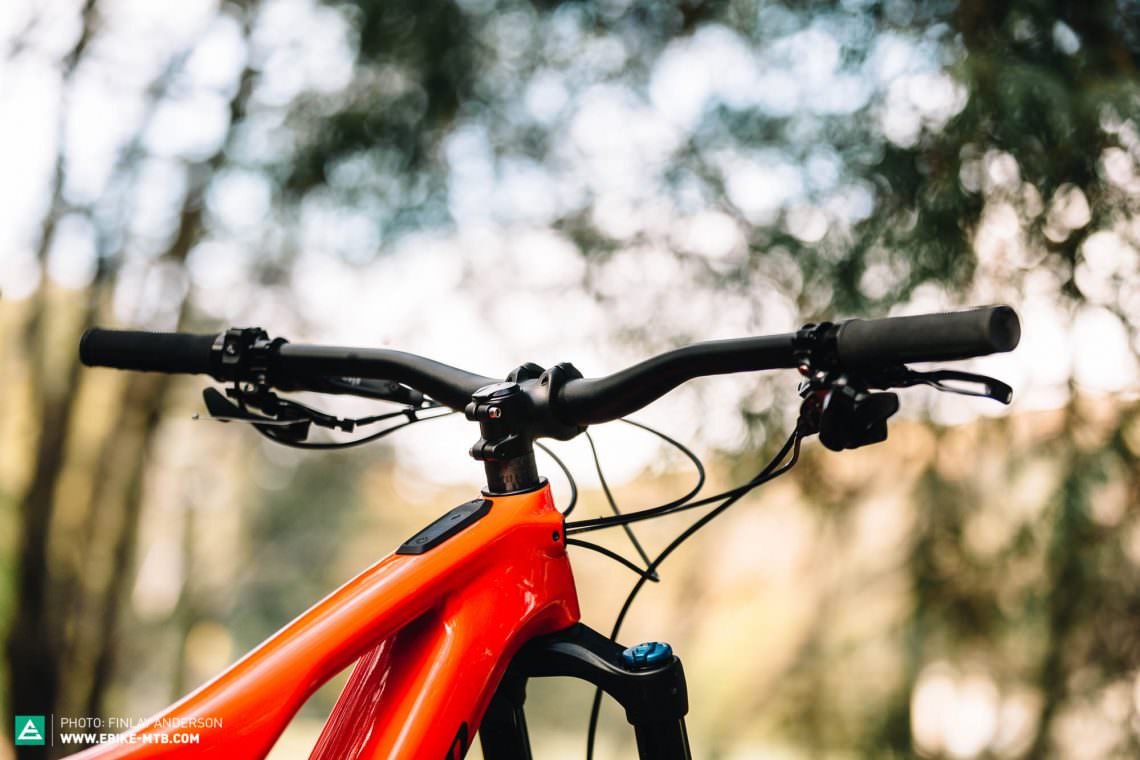
Changing your handlebar height
If you find that your bike is uncomfortable on long tours, or that the handling of your bike is lacking, you may want to experiment with a different handlebar height. Most eMTBs comes with spacers between the stem and the steerer tube, allowing 2–4 cm of adjustment of the handlebar height. If you have no spacers you can also fit a handlebar with more or less rise.
Low handlebar height
When you reduce the height of your handlebar your body weight is moved lower and towards the front wheel. When climbing, this results in increased steering stability and grip from the front wheel. However, when descending steep terrain, a low handlebar position results in a more demanding body position which requires more effort and strength from the rider’s arms, making it difficult to unweight the front wheel.
High handlebar height
Raising the handlebar height provides a more upright position for increased comfort on longer tours. Also, on steep descents you are more central on the bike, with your weight spread more evenly between the legs and arms, resulting in less fatigue. However, on flat trails and steep climbs, a higher handlebar position results in less weight on the front wheel reducing grip and control.
For an all-round eMTB setup that is fun, both up- and downhill, we recommend finding the highest handlebar position that maintains enough weight on the front wheel for controlled climbing. While there is no magic bullet solution to handlebar height and seat position, if you want to fine tune your bikes geometry we recommend experimenting with the adjustments to find out what works best for you.

In summary
Throughout their evolution we’ve seen eMTB’s mirror non-motorised trail bike geometry, but now times are changing. Given their increased versatility, we predict the future of eMTB geometry will focus less on radical values and that instead designers will take a more balanced approach. As increasingly compact battery and motors allow designers more freedom to optimise weight distribution and new suspension systems emerge that play more to the unique strengths of eMTBs, there is great potential to make the eMTB riding experience even more enjoyable.
Did you enjoy this article? If so, we would be stoked if you decide to support us with a monthly contribution. By becoming a supporter of E-MOUNTAINBIKE, you will help secure a sustainable future for high-quality cycling journalism. Click here to learn more.
Words & Photos:









